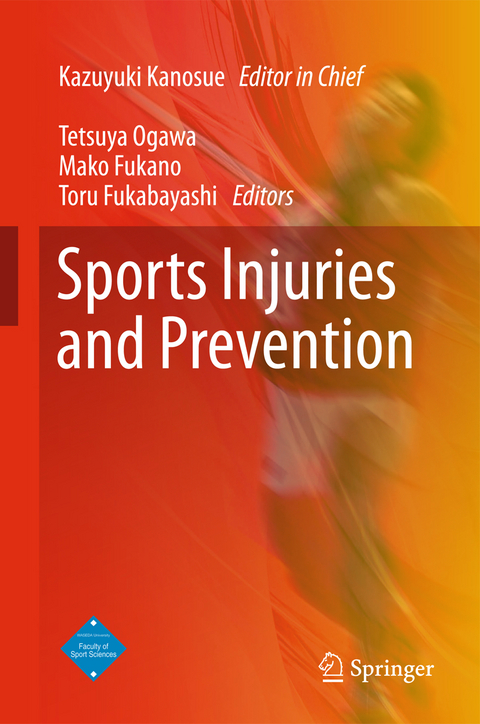
Sports Injuries and Prevention
Springer Verlag, Japan
978-4-431-55317-5 (ISBN)
The book is composed of seven parts. In the beginning part, current situations and the general characteristics of sports-related injuries are outlined on the basis of an investigation utilizing statistical data involving a large number of populations. In the following parts, detailed information on the injuries in terms of the types of sports activities, body sites, symptoms and the relationships among these factors are discussed. Part 2, for example, deals with topics on concussion and severe head–neck injuries which occur frequently in rugby and judo. In Parts 3 and 4, as one of the major sports-related injuries, anterior cruciate ligament (ACL) injuries are discussed. Beginning with the underlying mechanisms as assessed by using the latest measuring techniques, characteristic features of their occurrence are described. Further, Part 4 deals with topics on post-operative (ACL reconstruction) aspects of ACL injuries, especially those related to muscle functions and tendon regeneration in the hamstring muscles. Part 5 deals with muscle strain and focuses particularly on those occurring in the hamstring muscles, as this muscle group is known, as one of the most frequent sites of muscle strain. In Part 6, disorders related to the ankle and foot are introduced. Finally, Part 7 provides information on lower back disorders. Included are detailed mechanisms of their incidence, epidemiology and implications for their prevention.
Preface.- Part I: Sports Injury Surveillance.- Sports Injury Surveillance in Japan (from Sports Safety Association).- Sports Injury Surveillance in Japanese Junior and Senior High School Students.- Injury and Illness Surveillance among Olympic Athletes.- Part II: Concussion and Severe Head–Neck Injury.- Concussions in Junior Rugby Football Athletes and their Prevention.- Prevention of head and neck trauma in rugby.- Severe Head & Neck Injury and its Prevention in Judo.- Concussion and Severe Head-Neck Injury: An Approach for their Prevention in Rugby and Judo.- Part III: ACL Injury: Injury Mechanism, Prevention Programs and Their Usefulness.- Video analysis of ACL injuries in sports.- Video Analysis of ACL Injury Mechanisms Using a Model-Based Image-Matching Technique.- Injury Rate of Soccer Players and the Efficacy of the FIFA 11 + Program.- Biomechanical Studies on ACL Injury Risk Factor During Cutting; Utilizing the Point Cluster Technique.- Biomechanical Risk Factors and Prevention of Anterior Cruciate Ligament Injury.- Risk Factor Analysis of Female Soccer Tournament Players.- Prevention of Anterior Cruciate Ligament (ACL) Injury.- Anterior Cruciate Ligament Injury Prevention in Female Adolescents.- FIFA 11+ - Injury Prevention in Amateur Football - From Development to Worldwide Dissemination.- Influence of Changing Direction on the Center of Gravity and Knee Joint Angle in Rugby Players.- Anterior Cruciate Ligament Injury Prevention in Female Lacrosse Players Based on an Examination of Knee and Hip Joint Mechanics During Drop Vertical Jumps Performed While Holding a Lacrosse Stick.- ACL Injury Mechanism in Badminton: Survey of Injury Situation and Motion Analysis Study.- Part IV: ACL Injury: Post-Operative Rehabilitation, Recovery of Function and Tendon Regeneration.- Functional Hop Tests Contribute to Safe Return to Sports after Anterior Cruciate Ligament Reconstruction.- Biomechanical Adaptations in Subjects after Anterior Cruciate Ligament Reconstruction: Preventing Secondary Injury.- Morphology and Function of the Semitendinosus Muscle-Tendon Complex after Harvesting its Tendon for Anterior Cruciate Ligament Reconstruction.- Part V: Muscle Functions, Occurrence Mechanisms, and Program to Prevent Strain in the Hamstring Muscles.- Functional Differences among Hamstring Muscles in Hip Extension and Knee Flexion Exercises.- Anatomical and Functional Differences of Hamstrings.- Differences in Activation Patterns of the Hamstring Muscles during Sprinting.- The Relationship between Eccentric Exercise and Muscle Damage in Hamstring Muscles.- Risk factors and prevention of hamstring strain.- Part VI: Function in Arches of the Feet and Occurrence Mechanisms of Foot Disorders, Characteristics and Their Prevention.- Kinematics of the Foot and Ankle.- Biomechanical Analysis of the Effects of Footwear.- Risk Factors and Mechanisms of Fifth Metatarsal Stress Fracture.- Part VII: Lumbar Disorder and an Approach for Its Prevention.- Low Back Disorders Among Athletes and Its Prevention.- The Epidemiology of Low Back Disorders in Athletes.- The Prevention of Low Back Disorders in Divers.- Electromyographic Analysis of Deep Trunk Muscles During Sports Activities.
| Reihe/Serie | Sports Science and an Active Life ; .4 |
|---|---|
| Zusatzinfo | 72 Illustrations, color; 97 Illustrations, black and white; XIV, 413 p. 169 illus., 72 illus. in color. |
| Verlagsort | Tokyo |
| Sprache | englisch |
| Maße | 155 x 235 mm |
| Themenwelt | Medizin / Pharmazie ► Medizinische Fachgebiete ► Sportmedizin |
| Studium ► 1. Studienabschnitt (Vorklinik) ► Physiologie | |
| Studium ► Querschnittsbereiche ► Prävention / Gesundheitsförderung | |
| Sozialwissenschaften ► Pädagogik | |
| Schlagworte | Biomechanics and Neuromuscular Physiology • Education of Coaches and Athletes • GCOE Program in Japan • Injury Mechanism • Prevention Program and Intervention Results • Sports injury |
| ISBN-10 | 4-431-55317-7 / 4431553177 |
| ISBN-13 | 978-4-431-55317-5 / 9784431553175 |
| Zustand | Neuware |
| Haben Sie eine Frage zum Produkt? |
aus dem Bereich


